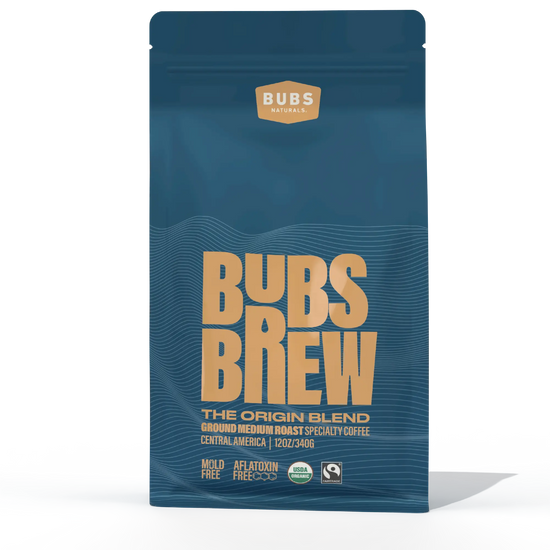Table of Contents
- Introduction
- What Is Mold-Free Coffee?
- How Does Mold Get Into Coffee Beans?
- Coffee Bean Quality and Sourcing
- How to Choose Mycotoxin-Free Coffee Brands
- The Benefits of Mold-Free Coffee
- DIY Tips to Minimize Mold Exposure
- Brewing and Storage Tips
- Conclusion
- FAQ
Introduction
Every day, millions of us reach for a cup of coffee as the ultimate morning ritual, a comforting companion during work breaks, or an energizing boost before workouts. However, lurking behind that steaming cup could be an unsettling reality: the potential presence of mold and mycotoxins. Did you know that up to 45% of commercial coffee beans can contain these harmful substances? It’s enough to make anyone think twice before taking that first sip.
At BUBS Naturals, we believe in the power of clean, functional supplements that support an active lifestyle. Our commitment to quality extends beyond our collagen peptides and MCT oil powder to encompass everything we consume, including coffee. Today, we’ll dive into the intricacies of understanding how to know if coffee is mold free, why it matters, and how to ensure that our daily brew aligns with our wellness goals.
In this blog post, we’ll explore the journey of coffee from bean to cup, the factors that contribute to mold growth, and the steps you can take to ensure your coffee is as pure as possible. Together, we’ll also highlight how BUBS Naturals prioritizes quality in our coffee collection, offering options that are not only delicious but also free from unwanted toxins.
Let’s get started on this journey to a cleaner coffee experience!
What Is Mold-Free Coffee?
Mold-free coffee refers to coffee that has been tested and processed to significantly reduce or eliminate mold spores and their byproducts, known as mycotoxins. These toxic compounds can form during various stages of coffee production, including harvesting, storage, and transportation, especially in humid conditions.
Why Should You Care About Mold in Coffee?
Mold and mycotoxins pose potential health risks, particularly for individuals with mold sensitivities or chronic health conditions. While most people may not experience immediate adverse effects from consuming small amounts of mycotoxins, chronic exposure can lead to long-term health complications. Research has linked certain mycotoxins to immune suppression, inflammation, and even more severe health issues.
Choosing mold-free coffee not only enhances your daily coffee ritual but also aligns with a broader commitment to personal wellness and sustainability. By opting for high-quality, tested coffee, we can enjoy our favorite beverage without the worry of unwanted contaminants.
How Does Mold Get Into Coffee Beans?
Understanding how mold infiltrates coffee beans is key to preventing its presence in our cups. Here are the primary stages during which mold can develop:
-
Harvesting: If coffee cherries are not dried properly after being harvested, they can retain moisture, creating ideal conditions for mold growth.
-
Processing: Coffee goes through various methods of processing, such as wet or dry processing. If beans are not handled with care, especially during wet processing, they can become susceptible to mold.
-
Storage: Improper storage in humid environments fosters mold growth. Coffee beans should be kept in airtight containers in cool, dry locations to maintain freshness and prevent contamination.
-
Transportation: Long transit times in unregulated conditions can expose beans to moisture, increasing the likelihood of mold development.
By recognizing these stages, we can make informed choices about the coffee we consume and prioritize brands that take proper care of their beans throughout the entire process.
Coffee Bean Quality and Sourcing
When it comes to selecting mold-free coffee, sourcing quality beans is paramount. Here's what to look for:
-
Single-Origin vs. Blended Beans: Single-origin beans are often grown and processed with greater care compared to mass-produced blends, as they typically come from specific regions known for their unique flavor profiles. Choosing single-origin coffee can enhance both taste and quality.
-
Organic vs. Conventional Beans: Organic beans are cultivated without synthetic pesticides, herbicides, or fertilizers, making them a better choice for those who prioritize environmental sustainability and health. Organic practices help maintain soil health and reduce the risk of mold contamination.
-
Certifications: Look for certifications such as USDA Organic, Fair Trade, and specialty grades. These certifications ensure that the coffee was grown, processed, and tested under rigorous standards, minimizing the risk of mold and mycotoxins.
At BUBS Naturals, we are proud to offer a selection of mold-free coffee options that not only meet high cupping scores but also align with our mission to provide clean, high-quality supplements. Our BUBS Brew Coffee is carefully sourced and tested to ensure it meets our standards for purity and quality.
How to Choose Mycotoxin-Free Coffee Brands
To further ensure your coffee is mold-free, consider the following tips:
-
Lab Testing: Opt for brands that actively test their coffee for mycotoxins. Transparency in testing practices is a good sign of quality.
-
Cupping Scores: Look for coffee with a cupping score of 80 or higher, which indicates a specialty-grade coffee that has been assessed for quality and flavor.
-
Research Brands: Take the time to research and reach out to coffee brands to inquire about their sourcing and testing practices. A reputable brand will gladly share this information.
-
Avoid Decaf Coffee: Caffeine acts as a natural mold inhibitor, so avoiding decaffeinated coffee may reduce the risk of mold exposure.
By following these guidelines, we can select brands that prioritize our health and provide us with a cleaner coffee experience.
The Benefits of Mold-Free Coffee
Choosing mold-free coffee comes with a range of advantages that extend beyond health concerns. Here are some key benefits:
-
Enhanced Flavor: Mold-free beans often taste fresher and cleaner, allowing the unique flavor profiles of the beans to shine through.
-
Improved Health: Reducing exposure to mycotoxins supports overall wellness and may prevent potential health issues associated with mold consumption.
-
Consistent Energy: Many consumers report avoiding the “crash” associated with lower-quality coffees, as mold-free options often provide steadier caffeine levels.
-
Peace of Mind: Knowing that your coffee has been carefully tested for mold and mycotoxins enhances the enjoyment of your daily brew.
-
Environmental Impact: Many mold-free coffee brands align with regenerative organic farming practices that enhance soil health and reduce reliance on chemical fertilizers.
At BUBS Naturals, we believe that every cup of coffee should contribute to both our health and the health of the planet. That’s why we prioritize sourcing our coffee from sustainable, ethical farms.
DIY Tips to Minimize Mold Exposure
In addition to choosing high-quality coffee, we can take proactive steps to minimize mold exposure in our coffee routines:
-
Store Coffee Properly: Always store coffee beans in airtight containers in a cool, dry place. Avoid refrigerating or freezing coffee, which can introduce moisture.
-
Regularly Clean Your Coffee Maker: Mold can grow in coffee makers if they are not cleaned regularly. Follow the manufacturer’s instructions for cleaning to maintain a safe brewing environment.
-
Use Filtered Water: Using filtered water can help reduce impurities and enhance the flavor of your coffee.
-
Grind Fresh: Grind coffee beans just before brewing to preserve flavor and prevent oxidation, which can lead to mold growth.
By integrating these simple practices into our coffee routine, we can enjoy a cleaner, more flavorful cup every time.
Brewing and Storage Tips
To get the most out of your mold-free coffee, consider these brewing and storage tips:
-
Brewing Methods: Employ brewing methods like French press or cold brew that allow for a gentle extraction of flavors without compromising the integrity of the beans.
-
Avoid Plastic Containers: When storing coffee beans, use glass or ceramic containers instead of plastic, which can absorb odors and moisture.
-
Check the Roast Date: Choose coffee that has a recent roast date to ensure maximum freshness and flavor.
By being mindful of these brewing and storage practices, we can enhance our coffee experience while minimizing exposure to mold and mycotoxins.
Conclusion
Navigating the world of coffee can be overwhelming, but understanding how to identify mold-free options is crucial for our health and wellness. By prioritizing high-quality, specially sourced coffee, we can enjoy our daily ritual without the worry of harmful contaminants.
At BUBS Naturals, we are committed to providing clean, science-backed supplements that support our active lifestyles, and our coffee collection is no exception. Together, let’s raise our cups to a cleaner, healthier coffee experience that fuels both our bodies and our passion for adventure.
FAQ
What is mold-free coffee? Mold-free coffee is coffee that has been tested and processed to significantly reduce or eliminate mold spores and mycotoxins.
How can I know if my coffee is mold-free? Look for brands that test their coffee for mycotoxins and have certifications such as USDA Organic or Fair Trade. Reputable brands often provide information about their testing processes.
Can I get sick from mold-free coffee? While mold-free coffee is generally safe, some individuals may still experience sensitivities. It's important to choose high-quality, tested coffee to minimize risks.
What should I look for when choosing coffee to avoid mold? Choose single-origin, organic coffee with high cupping scores and look for brands that prioritize transparency in their sourcing and testing practices.
How can I store my coffee to prevent mold? Store coffee beans in airtight containers in a cool, dry place, and avoid refrigerating or freezing them. Regularly clean your coffee maker to prevent mold growth.
By incorporating these tips and choosing brands like BUBS Naturals, we can savor our coffee with peace of mind, knowing that we are making healthier choices for ourselves and the planet.
Written by:
Bubs Naturals

Origin Blend Coffee | Medium Roast
Starts at $17.95
Shop

